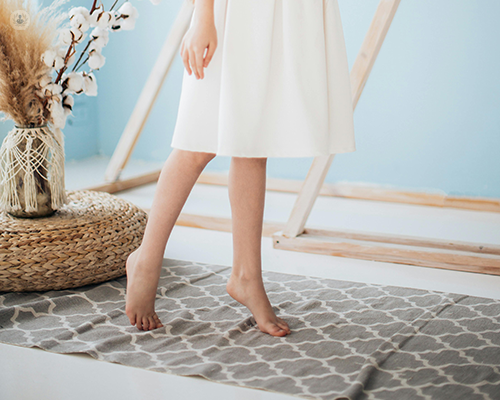Toe walking in children: A parent’s guide
Written in association with:Toe walking is a common concern among parents. While many children outgrow it naturally, persistent toe walking should be evaluated by a specialist to rule out potential complications.
This article explains what toe walking is, when to consult a specialist, and how it can be treated and managed.

What is toe walking?
Toe walking is a walking pattern where a child walks on the balls of their feet, with their heels rarely or never touching the ground. This behaviour is common in toddlers learning to walk, as they explore balance and coordination.
In some cases, toe walking has no identifiable cause and is referred to as idiopathic toe walking. In other cases, there are various potential reasons for this walking pattern:
Neurological conditions: Toe walking can sometimes be linked to conditions such as cerebral palsy, muscular dystrophy, or spinal cord abnormalities.
Autism spectrum disorder: Toe walking is more prevalent in children with autism. While not all children with autism toe walk, it’s a recognised pattern in some cases.
Tight calf muscles or Achilles tendon: If the calf muscles or Achilles tendon are shortened or tight, it can physically limit the ability to place the heels on the ground during walking.
When should I consult a specialist about my child’s toe walking?
Most children outgrow toe walking as their motor skills mature. However, if toe walking persists beyond the age of 2 or 3, it should be evaluated by a specialist, such as a paediatric orthopaedic surgeon.
Persistent toe walking, if untreated, can lead to complications such as:
Muscle tightness: Tightening of the calf muscles or Achilles tendon due to prolonged toe walking can reduce ankle flexibility, making walking increasingly difficult.
Foot deformities: Chronic toe walking can place unusual stress on the foot, leading to issues such as bunions, hammertoes, or other structural abnormalities.
Balance and stability problems: Toe walking can affect balance, increasing the risk of falls or difficulty engaging in physical activities.
Your child’s paediatric orthopaedic surgeon will evaluate your child’s medical history, conduct a physical examination, and, if necessary, recommend imaging or other diagnostic tests to identify any underlying conditions.
How is toe walking in children treated and managed?
Treatment for toe walking depends on its cause, the child’s age, and the severity of the condition. Early intervention is instrumental to prevent long-term complications.
Observation and monitoring: If toe walking is idiopathic, and your child shows no signs of developmental or neurological conditions, a “wait and see” approach may be advised.
Physiotherapy: For younger children or those with mild cases, physiotherapy is often the first line of treatment. Exercises to stretch and strengthen the calf muscles and Achilles tendon help improve flexibility and range of motion, as well as balance and stability, encouraging a normal walking pattern.
Orthotic devices: If physiotherapy doesn’t resolve the issue, orthotics such as braces or splints may be recommended. Orthotics devices stretch tight muscles and tendons, encouraging proper foot placement and providing support for correct heel-to-ground contact during walking.
Serial casting: In cases where muscle tightness is significant, serial casting may be employed. This involves placing a series of casts on your child’s lower legs over a period of weeks to gradually lengthen the calf muscles and Achilles tendon.
Is surgery ever necessary for toe walking in children?
Surgery is typically considered a last resort and is only recommended in cases where conservative treatments have failed, or when toe walking is caused by long-standing severe contractures or deformities.
The most common surgical procedure for toe walking is Achilles tendon lengthening to increase the flexibility of the tendon, allowing the heel to make proper contact with the ground. Another option, depending on the cause, is gastrocnemius recession, which specifically targets tight calf muscles.
Post-surgery, recovery involves a period of immobilisation, followed by rehabilitation to restore strength and retrain gait patterns.


